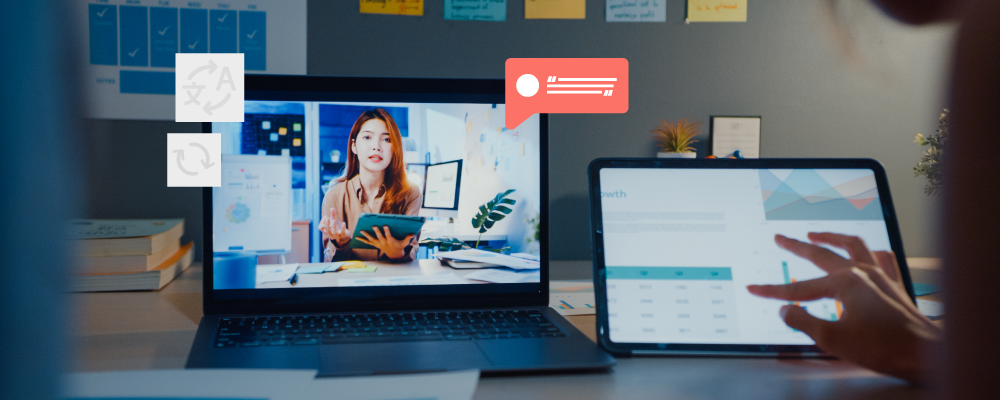As learning becomes increasingly digital, so does the content you create. Gone are the days of relying on simple text to share information; now, we have audio, video, infographics, and multimedia to make our e-learning courses interactive and engaging. Here are 10 expert tips for effectively localizing your multimedia content to take your e-learning to a global stage!
1. Plan for localization from the beginning
Planning for localization from the beginning is crucial for ensuring an effective and efficient localization process. This means the e-learning content should be designed with localization in mind, and all relevant stakeholders should be involved in the planning process. By considering localization from the outset, the e-learning content can be created in a way that is culturally appropriate and linguistically relevant to the target audience. You can avoid costly and time-consuming rework by including localization considerations early on.
For example, if you plan to create an e-learning course that will be used in multiple languages, consider creating a style guide that outlines guidelines for how text, images, and multimedia elements should be used. This can help ensure language consistency and reduce the need for extensive rework. Additionally, involving professional translators in the planning process can help identify any potential localization issues and ensure that the e-learning content is optimized for the target audience.
2. Use a content management system (CMS)
Using a CMS can help to streamline the localization process by centralizing all of the e-learning content in one place. This can make it easier to manage updates and translations, as well as ensure consistency in the localized content. With a CMS, changes to the original content are automatically reflected in the localized versions, reducing the time and effort required for updates.
This is especially important for larger e-learning projects with multiple modules or versions in different languages. A CMS can provide a single source of truth for all content, with easy access and version control for translators and reviewers. Consider using a CMS with built-in localization features or integrating with a translation management system (TMS) for even greater efficiency.
What is LMS in learning?
A Learning Management System (LMS) is an online integrated software used for creating, delivering, tracking, and reporting educational courses and outcomes. It can be used to support traditional face-to-face instruction, as well as blended/hybrid and distance learning environments.
3. Use simple language and clear visuals
E-learning content should be designed with simple language and clear visuals that are easy to understand, even for non-native speakers. This can help to reduce localization challenges and make the content more accessible to a wider audience. Avoid using overly complex language or jargon that may be difficult for non-native speakers to understand.
Choose visuals that are universally understood, such as icons or simple graphics, and avoid cultural references that may not be familiar to all audiences. Remember, the goal of localization is to make the content as clear and effective as possible for the target audience.
4. Use neutral imagery and examples
When creating e-learning content, it is important to avoid using imagery and examples specific to a particular culture or location. This can make localization more difficult and limit the potential audience for the content. Instead, use neutral imagery and examples that a global audience can easily understand. This approach can also help to prevent cultural misinterpretation or offense, which could negatively impact the success of your e-learning program.
5. Use translation-friendly formats
When creating e-learning content, use formats that are easy to translate, such as plain text files or XML formats, and avoid using proprietary formats that may require specialized tools or software to access. By using translation-friendly formats, you can streamline the localization process and ensure that your content can be easily and accurately translated for a global audience.
6. Conduct cultural research
Conducting cultural research on the target audience can ensure that e-learning content is appropriate for the local context and identify potential localization issues. For example, you may need to adapt content to comply with local regulations, or adjust visuals to match local customs or traditions. Cultural research can also help to identify potential challenges, such as technical limitations or linguistic nuances, and inform decisions on localization strategy.
7. Work with professional translators
Professional translators can help to ensure that e-learning content is accurately translated and localized for the target audience. Choose translators who are fluent in both the source and target languages, and who have experience with e-learning localization. Consider using a translation agency or freelance translator with a strong reputation and a proven track record of delivering high-quality translations on time.
8. Perform quality assurance checks
Conduct thorough QA checks to ensure the localized e-learning content is accurate, culturally appropriate, and error-free. Quality assurance should be performed at multiple stages of the localization process, including translation, editing, and final proofreading. Use native-speaking reviewers and subject matter experts to review the localized content and identify any issues or errors. This step is critical to ensure the success of your e-learning program and prevent any negative impact on your brand reputation.
9. Test the content in the target environment
Test the localized e-learning content in the target environment to ensure that it works correctly and that any cultural or technical issues are identified and addressed. This includes testing on different devices and web browsers to ensure compatibility, as well as conducting user testing with members of the target audience to gather feedback on the user experience. The feedback received during user testing can then be used to make any necessary adjustments before launching the localized e-learning program, which can ultimately lead to a more successful localization.
10. Continuously update and maintain the content
E-learning content should be updated and maintained regularly to ensure that it remains relevant and up-to-date for the target audience and to address any localization issues that may arise over time. For instance, as the target audience changes or expands, new localization challenges may emerge that were not previously anticipated. To maintain e-learning content effectively, it’s important to have a plan in place. This can include setting a regular review schedule, establishing a process for gathering and incorporating feedback, and designating a team or individual responsible for managing updates. By prioritizing regular updates and maintenance, you can ensure that your e-learning program remains a valuable resource for your target audience, regardless of their location.
Looking to take your e-learning program global? Prime Group offers expert multimedia localization services, including e-learning courses and tutorials, into multiple languages. Our team masters all editing techniques to adapt audio, video, graphics, and other multimedia elements for global audiences. With our world-class localization, we’ll help you break down language and cultural barriers and create a seamless learning experience that resonates with your target audience worldwide. Partner with Prime Group to unlock the full potential of your content and take your e-learning to the next level.



